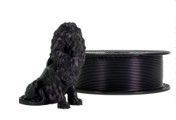(3D printer) FILAMENT, basic PLA, Ø 1.75mm, black, 1kg
Valid Article
(3D printer) FILAMENT, +, Ø 1.75mm
Form
Filament for 3D printer, fused deposition modelling technology (FDM), roll:
- Colour: available in different colours
- Diameter: 1.75 mm
- Material: available in different materials
- Packaging: 1 roll (weight may vary)
Features depending on the material used:
Basic PLA
Easy to print
Can print tiny parts
Can print huge objects
Hard and tough
Low warping
Low thermal resistance
Not suitable for outdoor use
Brittle
Basic PETG
Good high-temperature resistance
Easy to print
Low shrinking and warping
High strength and durability
Easier to sand than PLA (softer, less melting)
Worse details than PLA, for example
Possibility of stringing
Poor bridging characteristics
PETG V0
A unique UL-certifiedself-extinguishing filament
Perfect for plastic parts in electronicappliances
Good high-temperatureresistance
Good chemicalresistance
Low shrinkingandwarping
High strengthanddurability
Halogen-free (lessharmful fumes whenburning)
Easy to print
Hygroscopicmaterial (needsdryingbeforeprinting)
Prone to stringingandoozing
WorsedetailsthanPLA, for example
The UL certification appliesonly for printingwith Original Prusa MK3S+, MK4, and XL andpproved profiles in PrusaSlicer
PC Blend
High temperature resistance up to 113°C
High impact and wear resistance (very strong and rigid material)
Good dimensional stability in comparison with other PC filaments
Prints don't deform under pressure over time
Good electrical insulating properties
Styrene-free (non-toxic compared to ASA)
Very low moisture absorption
Large models have a tendency to warp
Requires high heatbed and nozzle temperatures
Produces minor odors during printing
TPU flexible
High wear and abrasion resistance
Very good low-temperature flexibility
High tensile strength and outstanding resistance to tear propagation
Excellent damping characteristics
High resistance to oils, greases, oxygen and ozone
Biocompatible
PC Blend Carbon Fiber (PCCF)
High impact and wear resistance (very strong and rigid material)
Great high-temperature resistance (up to 114°C)
Possibility of annealing (improving resistance up to 130 °C)
Good UV stability and resistance to common chemicals
Great dimensional stability – possible to print large models without an enclosure
No need for drying prior to printing
Requires hardened nozzle
More brittle than Prusament PC Blend
Lower thickness precision (0.04 mm) caused by carbon fibers inside
ASA
Great for outside use – UV stable
Good high-temperature resistance
Detailed prints without a stringing effect
Can be smoothed with acetone vapors
Can be easily sanded / post-processed
Good mechanical resistance
Large models have a tendency to warp
Produces a slight odor of burned plastic during printing (less than ABS)
Contains styrene
Contains styrene (potentially harmful fumes)
Slightly hygroscopic (absorbs moisture)
Fit
All 3D printer, with fused deposition modeling technology (FDM).
Function
The filament is the material used to make the 3D print.

